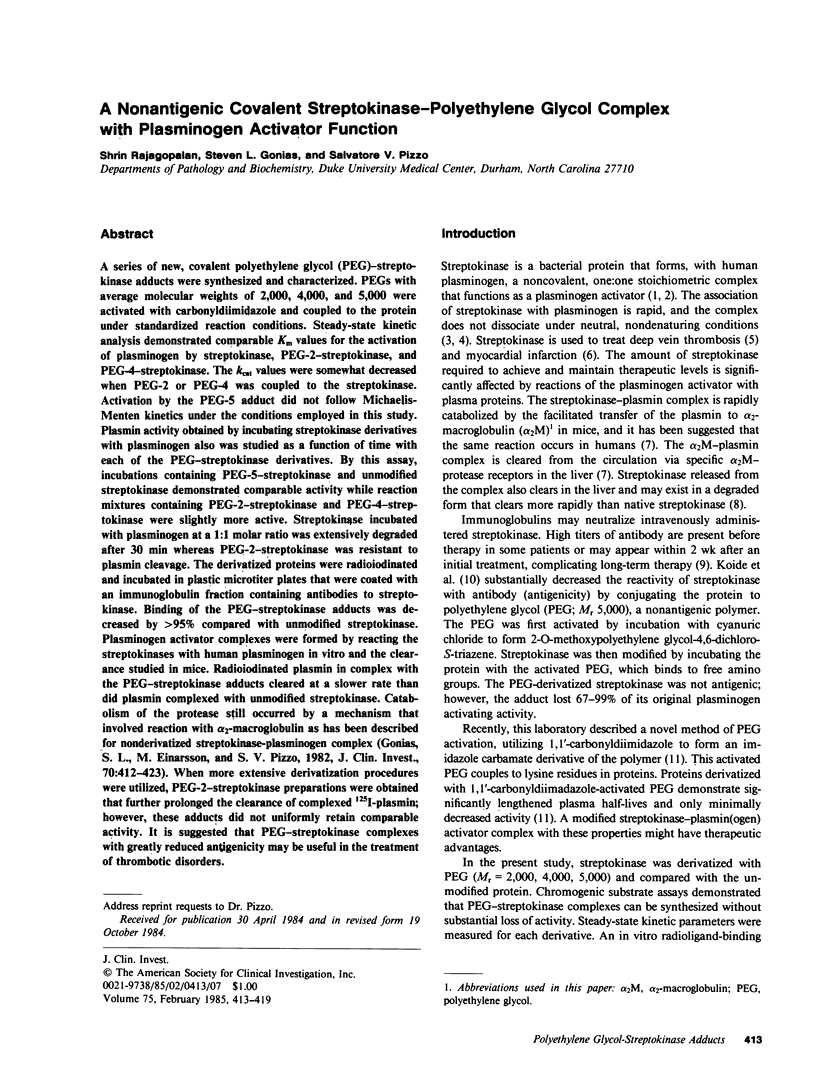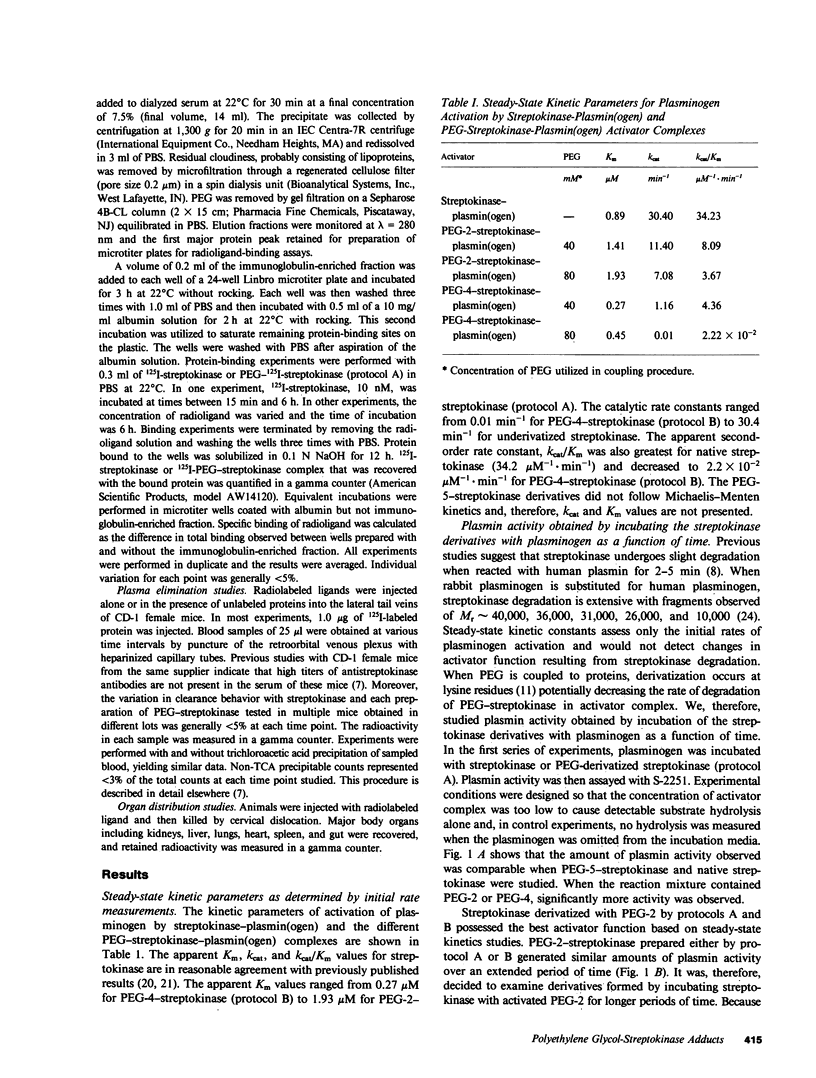Abstract
A series of new, covalent polyethylene glycol (PEG)-streptokinase adducts were synthesized and characterized. PEGs with average molecular weights of 2,000, 4,000, and 5,000 were activated with carbonyldiimidazole and coupled to the protein under standardized reaction conditions. Steady-state kinetic analysis demonstrated comparable Km values for the activation of plasminogen by streptokinase, PEG-2-streptokinase, and PEG-4-streptokinase. The kcat values were somewhat decreased when PEG-2 or PEG-4 was coupled to the streptokinase. Activation by the PEG-5 adduct did not follow Michaelis-Menten kinetics under the conditions employed in this study. Plasmin activity obtained by incubating streptokinase derivatives with plasminogen also was studied as a function of time with each of the PEG-streptokinase derivatives. By this assay, incubations containing PEG-5-streptokinase and unmodified streptokinase demonstrated comparable activity while reaction mixtures containing PEG-2-streptokinase and PEG-4-streptokinase were slightly more active. Streptokinase incubated with plasminogen at a 1:1 molar ratio was extensively degraded after 30 min whereas PEG-2-streptokinase was resistant to plasmin cleavage. The derivatized proteins were radioiodinated and incubated in plastic microtiter plates that were coated with an immunoglobulin fraction containing antibodies to streptokinase. Binding of the PEG-streptokinase adducts was decreased by greater than 95% compared with unmodified streptokinase. Plasminogen activator complexes were formed by reacting the streptokinases with human plasminogen in vitro and the clearance studied in mice. Radioiodinated plasmin in complex with the PEG-streptokinase adducts cleared at a slower rate than did plasmin complexed with unmodified streptokinase. Catabolism of the protease still occurred by a mechanism that involved reaction with alpha 2-macroglobulin as has been described for nonderivatized streptokinase-plasminogen complex (Gonias, S. L., M. Einarsson, and S. V. Pizzo, 1982, J. Clin. Invest., 70:412-423). When more extensive derivatization procedures were utilized, PEG-2-streptokinase preparations were obtained that further prolonged the clearance of complexed 125I-plasmin; however, these adducts did not uniformly retain comparable activity. It is suggested that PEG-streptokinase complexes with greatly reduced antigenicity may be useful in the treatment of thrombotic disorders.
Full text
PDF






Selected References
These references are in PubMed. This may not be the complete list of references from this article.
- Abuchowski A., van Es T., Palczuk N. C., McCoy J. R., Davis F. F. Treatment of L5178Y tumor-bearing BDF1 mice with a nonimmunogenic L-glutaminase-L-asparaginase. Cancer Treat Rep. 1979 Jun;63(6):1127–1132. [PubMed] [Google Scholar]
- Beauchamp C. O., Gonias S. L., Menapace D. P., Pizzo S. V. A new procedure for the synthesis of polyethylene glycol-protein adducts; effects on function, receptor recognition, and clearance of superoxide dismutase, lactoferrin, and alpha 2-macroglobulin. Anal Biochem. 1983 May;131(1):25–33. doi: 10.1016/0003-2697(83)90131-8. [DOI] [PubMed] [Google Scholar]
- Brockway W. J., Castellino F. J. A characterization of native streptokinase and altered streptokinase isolated from a human plasminogen activator complex. Biochemistry. 1974 May 7;13(10):2063–2070. doi: 10.1021/bi00707a010. [DOI] [PubMed] [Google Scholar]
- Brockway W. J., Castellino F. J. Measurement of the binding of antifibrinolytic amino acids to various plasminogens. Arch Biochem Biophys. 1972 Jul;151(1):194–199. doi: 10.1016/0003-9861(72)90488-2. [DOI] [PubMed] [Google Scholar]
- Castellino F. J., Sodetz J. M., Brockway W. J., Siefring G. E., Jr Streptokinase. Methods Enzymol. 1976;45:244–257. doi: 10.1016/s0076-6879(76)45024-3. [DOI] [PubMed] [Google Scholar]
- Cederholm-Williams S. A., De Cock F., Lijnen H. R., Collen D. Kinetics of the reactions between streptokinase, plasmin and alpha 2-antiplasmin. Eur J Biochem. 1979 Oct;100(1):125–132. doi: 10.1111/j.1432-1033.1979.tb02040.x. [DOI] [PubMed] [Google Scholar]
- Collen D. On the regulation and control of fibrinolysis. Edward Kowalski Memorial Lecture. Thromb Haemost. 1980 Jun 18;43(2):77–89. [PubMed] [Google Scholar]
- David G. S., Reisfeld R. A. Protein iodination with solid state lactoperoxidase. Biochemistry. 1974 Feb 26;13(5):1014–1021. doi: 10.1021/bi00702a028. [DOI] [PubMed] [Google Scholar]
- De Renzo E. C., Siiteri P. K., Hutchings B. L., Bell P. H. Preparation and certain properties of highly purified streptokinase. J Biol Chem. 1967 Feb 10;242(3):533–542. [PubMed] [Google Scholar]
- Deutsch D. G., Mertz E. T. Plasminogen: purification from human plasma by affinity chromatography. Science. 1970 Dec 4;170(3962):1095–1096. doi: 10.1126/science.170.3962.1095. [DOI] [PubMed] [Google Scholar]
- Einarsson M., Skoog B., Forsberg B., Einarsson R. Characterization of highly purified native streptokinase and altered streptokinase after alkaline treatment. Biochim Biophys Acta. 1979 May 10;568(1):19–29. doi: 10.1016/0005-2744(79)90269-9. [DOI] [PubMed] [Google Scholar]
- Gonias S. L., Balber A. E., Hubbard W. J., Pizzo S. V. Ligand binding, conformational change and plasma elimination of human, mouse and rat alpha-macroglobulin proteinase inhibitors. Biochem J. 1983 Jan 1;209(1):99–105. doi: 10.1042/bj2090099. [DOI] [PMC free article] [PubMed] [Google Scholar]
- Gonias S. L., Einarsson M., Pizzo S. V. Catabolic pathways for streptokinase, plasmin, and streptokinase activator complex in mice. In vivo reaction of plasminogen activator with alpha 2-macroglobulin. J Clin Invest. 1982 Aug;70(2):412–423. doi: 10.1172/JCI110631. [DOI] [PMC free article] [PubMed] [Google Scholar]
- Gonias S. L., Einarsson M., Pizzo S. V. Catabolic pathways for streptokinase, plasmin, and streptokinase activator complex in mice. In vivo reaction of plasminogen activator with alpha 2-macroglobulin. J Clin Invest. 1982 Aug;70(2):412–423. doi: 10.1172/JCI110631. [DOI] [PMC free article] [PubMed] [Google Scholar]
- Gonias S. L., Fuchs H. E., Pizzo S. V. A unique pathway for the plasma elimination of alpha 2-antiplasmin-protease complexes in mice. Thromb Haemost. 1982 Oct 29;48(2):208–210. [PubMed] [Google Scholar]
- Gonias S. L., Pizzo S. V. Conformation and protease binding activity of binary and ternary human alpha 2-macroglobulin-protease complexes. J Biol Chem. 1983 Dec 10;258(23):14682–14685. [PubMed] [Google Scholar]
- Gonzalez-Gronow M., Siefring G. E., Jr, Castellino F. J. Mechanism of activation of human plasminogen by the activator complex, streptokinase-plasmin. J Biol Chem. 1978 Feb 25;253(4):1090–1094. [PubMed] [Google Scholar]
- Hall P. K., Roberts R. C. Physical and chemical properties of human plasma alpha2-macroglobulin. Biochem J. 1978 Jul 1;173(1):27–38. doi: 10.1042/bj1730027. [DOI] [PMC free article] [PubMed] [Google Scholar]
- Imber M. J., Pizzo S. V. Clearance and binding of two electrophoretic "fast" forms of human alpha 2-macroglobulin. J Biol Chem. 1981 Aug 10;256(15):8134–8139. [PubMed] [Google Scholar]
- Koide A., Suzuki S., Kobayashi S. Preparation of polyethylene glycol-modified streptokinase with disappearance of binding ability towards anti-serum and retention of activity. FEBS Lett. 1982 Jun 21;143(1):73–76. doi: 10.1016/0014-5793(82)80276-7. [DOI] [PubMed] [Google Scholar]
- McClintock D. K., Bell P. H. The mechanism of activation of human plasminogen by streptokinase. Biochem Biophys Res Commun. 1971 May 7;43(3):694–702. doi: 10.1016/0006-291x(71)90670-x. [DOI] [PubMed] [Google Scholar]
- POLSON A., POTGIETER G. M., LARGIER J. F., MEARS G. E., JOUBERT F. J. THE FRACTIONATION OF PROTEIN MIXTURES BY LINEAR POLYMERS OF HIGH MOLECULAR WEIGHT. Biochim Biophys Acta. 1964 Mar 16;82:463–475. doi: 10.1016/0304-4165(64)90438-6. [DOI] [PubMed] [Google Scholar]
- Porter J. M., Goodnight S. H., Jr The clinical use of fibrinolytic agents. Am J Surg. 1977 Aug;134(2):217–221. doi: 10.1016/0002-9610(77)90348-8. [DOI] [PubMed] [Google Scholar]
- Pyatak P. S., Abuchowski A., Davis F. F. Preparation of a polyethylene glycol: superoxide dismutase adduct, and an examination of its blood circulation life and anti-inflammatory activity. Res Commun Chem Pathol Pharmacol. 1980 Jul;29(1):113–127. [PubMed] [Google Scholar]
- Siefring G. E., Jr, Castellino F. J. Interaction of streptokinase with plasminogen. Isolation and characterization of a streptokinase degradation product. J Biol Chem. 1976 Jul 10;251(13):3913–3920. [PubMed] [Google Scholar]
- Sjöholm I. Studies on the conformational changes of plasminogen induced during activation to plasmin and by 6-aminohexanoic acid. Eur J Biochem. 1973 Nov 15;39(2):471–479. doi: 10.1111/j.1432-1033.1973.tb03146.x. [DOI] [PubMed] [Google Scholar]
- Spöttl F., Kaiser R. Rapid detection and quantitation of precipitating streptokinase-antibodies. Thromb Diath Haemorrh. 1974 Dec 31;32(2-3):608–616. [PubMed] [Google Scholar]
- Theiss W., Asbeck F., Kriessmann A., Trübestein G., Knoch K., de Swart C. A., Marbert G. A., van de Loo J. C. Systemic fibrinolytic activity and inhibitor levels during treatment of deep vein thrombosis with urokinase and streptokinase. Thromb Haemost. 1983 Oct 31;50(3):664–668. [PubMed] [Google Scholar]
- Wohl R. C., Summaria L., Arzadon L., Robbins K. C. Steady state kinetics of activation of human and bovine plasminogens by streptokinase and its equimolar complexes with various activated forms of human plasminogen. J Biol Chem. 1978 Mar 10;253(5):1402–1407. [PubMed] [Google Scholar]
- Wohl R. C., Summaria L., Robbins K. C. Kinetics of activation of human plasminogen by different activator species at pH 7.4 and 37 degrees C. J Biol Chem. 1980 Mar 10;255(5):2005–2013. [PubMed] [Google Scholar]


